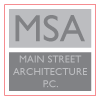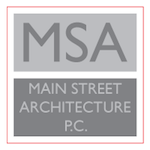Architect’s Process
The architect’s best practice design effort is typically divided into phases of work and services. This division of work informs the client of where the project and completed work stands and what will come next. The phases are in sequential order that build upon the previous client approved phase. At MSA, we have developed a streamlined work flow that reduces duplication in time and effort.
- 1. INITIAL MEETING
- 2. DOCUMENTATION (D)
- 3. SCHEMATIC DESIGN (SD)
- 4. DESIGN DEVELOPMENT (DD)
- 5. CONSTRUCTION DOCUMENTS (CD)
- 6. BIDDING AND NEGOTIATIONS (BN)
- 7. CONSTRUCTION ADMINISTRATION (CA)
- 8. FOLLOWUP
MSA will meet with a potential client on the owner’s site and discuss the program goals and requirements. The onsite meeting allows for discussion of the client’s requirements, observations and discovery of potential limitations. Unless the client needs only consultation this initial meeting is normally free of charge and will result in MSA developing a written proposal outlining our understanding of the project and associated fees. The proposal will be broken down into the following phases of work, as required. We try hard to avoid surprising a client with our fees and the cost of construction.
When an existing structure is involved, MSA will fully measure and photograph the necessary structures and create 2-dimensional as-built digital computer files that may include floor plans, building sections, and wall elevations. This work sometimes requires demolition to fully document the structure. If required, this will always be discussed with the client.
Schematic design defines the architectural program and includes study drawings, documents or other media that illustrate the initial concept and site features. Sometimes a preliminary phase is needed to assist the client with developing a program of needs. Schematic design also includes research into health and zoning requirements. MSA will present and describe the scheme and consult and discuss with the client to produce a final schematic design. Our schematic designs are usually drawn on the computer and are very accurate versus hand drawn sketches. We then build our detailed set off of the first drawings. Preliminary budget cost estimates can then be obtained. MSA prefers to obtain cost estimates from an estimator or contractor familiar with the type of project. The level of sustainable design will be integrated in to the design. The method of selecting a contractor will be made and the level of detail in the CD’s will be made in this phase. Following the client’s approval, the design then moves forward to the design development phase.
If the project requires approvals or certifications, the next secondary phase may be submitting a scheme for review and consultation with other professionals. A few examples of this type of review are:
- Local historic district review
- State and Federal historic reviews
- Certifications like LEED or EarthCraft
- Zoning variances
- Grant requirements
- Note that a surveyor or civil site engineer is typically hired by the client as soon as possible.
If the client desires, MSA can provide 3-dimensial computer modeling of the schematic design and provide images that can be used for marketing. This currently requires additional time and computer work than our streamlined 2-dimensional designs for permit.
Using the schematic design documents, we will take them one step further. This phase involves structural, HVAC, and systems integration. Design deliverables can include dimensions, additional drawings including wall sections, and details with options considered. Material outline finishes are discussed, and door and window selections are made. Our custom designs meet the building code and are sometimes designed above the code minimum. This phase will conclude with presentation to, and approval, by the client.
After the client and architect are satisfied with the documents produced in design development MSA will move forward in drawings and specifications in much greater detail. Typically, this includes consultant designers and engineers. The level of detail in CD’s can vary depending on the owner’s preference and the chosen method of selecting a contractor. The client should know that design revisions in this phase can require significant effort and delays from multiple professionals working on numerous coordinated drawings. Preliminary sets of drawings can be estimated for cost. If the CD set is not 100 percent complete it will be noted on the drawings as not for construction use. The conclusion of this phase will result in a set of documents that is ready for permit application and include pertinent information for the contractor to price and build the project.
Consultation with other design professionals will occur as required by the program. A few examples of this type of work are:
- Engineering including structural, HVAC, plumbing, electrical, and civil site design
- Interior designer
- Kitchen designer
- Security designer
- Acoustical designer
- Special lighting designer
- Home theater designer
The method of selecting a contractor will have already been determined prior to DD. MSA will assist the client with bid documents. Documents that may be required include advertisement of bid, bid instructions, the bid form, bid documents, the proposed owner-contractor draft agreement, insurance and possible bond requirements, etc. Some projects have unique and complex requirements. MSA provides advice on evaluation of bids or negotiations to determine the contractor selection. Please note that MSA does not provide legal advice. The final step is to select a contractor and allow construction to begin.
Construction administration services are provided at the client’s discretion and are outlined in the owner-architect agreement on larger projects. Services begin with the initial construction agreement and conclude when the final certificate of payment is issued. The architect’s responsibility is to represent the client’s interest, mediate discussions, and to assist the contractor to build the project as specified in the CD’s as approved by the owner. Work can include answering questions that may arise on site, provide drawings to clarify questions, field inspections and reports, application for payment processing, review of fabrication shop drawings and material submittals, and processing of change orders.
This phase concludes the MSA’s normal services and the result is a successful construction project.
MSA would like to be involved with the project as the client settles into the new work. If problems arise with quality of the work or warranty work is required, please give us a call to assist in conversations with the contractor. The normal contractor construction warranty in Virginia is for 1 year.
MSA would like to photograph the completed work for our use and possible inclusion on the web site.
And MSA loves to work with repeat clients.

